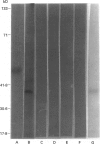Abstract
The ability of non-professional antigen-presenting cells (APC) to process and present antigen to the immune system has been the subject of debate in autoimmunity and tumour immunology. The role of muscle cells in the processing and presentation of antigen to T cells via class I and class II MHC pathways is of increasing interest. Muscle cells are the targets of autoimmune attack in the inflammatory muscle diseases, and direct intramuscular injection of antigen-expressing DNA constructs is under scrutiny as a means of vaccination. Furthermore, the immunological properties of muscle cells are of relevance in attempts to transfer myoblasts as replacement cells in dystrophic diseases or as depot cells for the secretion of certain molecules in deficiency states. Using class I and class II MHC transfectant clones of the C2C12 myoblast cell line, myoblasts have been shown to be capable of presenting antigen to, and stimulating secretion of IL-2 by, T cell hybridomas via both of these pathways. The epitopes which are dominantly presented by professional APC after processing of native antigens were also presented by the myoblast cell line after processing of either ovalbumin (class I) or hen egg lysozyme (class II). Further, antigen processing and presentation via the class II pathway were enhanced by pretreatment of the myoblasts with interferon-gamma (IFN-gamma). Up-regulation of invariant chain expression by this treatment may have contributed to this enhanced presentation, but an effect of IFN-gamma on the expression of other molecules such as H-2 DM may have also played a role. The demonstration of the antigen-presenting properties of these myoblasts is of relevance to all three areas mentioned above. In each situation myoblasts comprise a significant population within muscle. In the case of inflammatory muscle diseases the process of muscle degeneration and regeneration is on-going, while in the vaccination procedure some muscle damage occurs, and vaccination is more effective when muscle damage has preceded inoculation.
Full text
PDF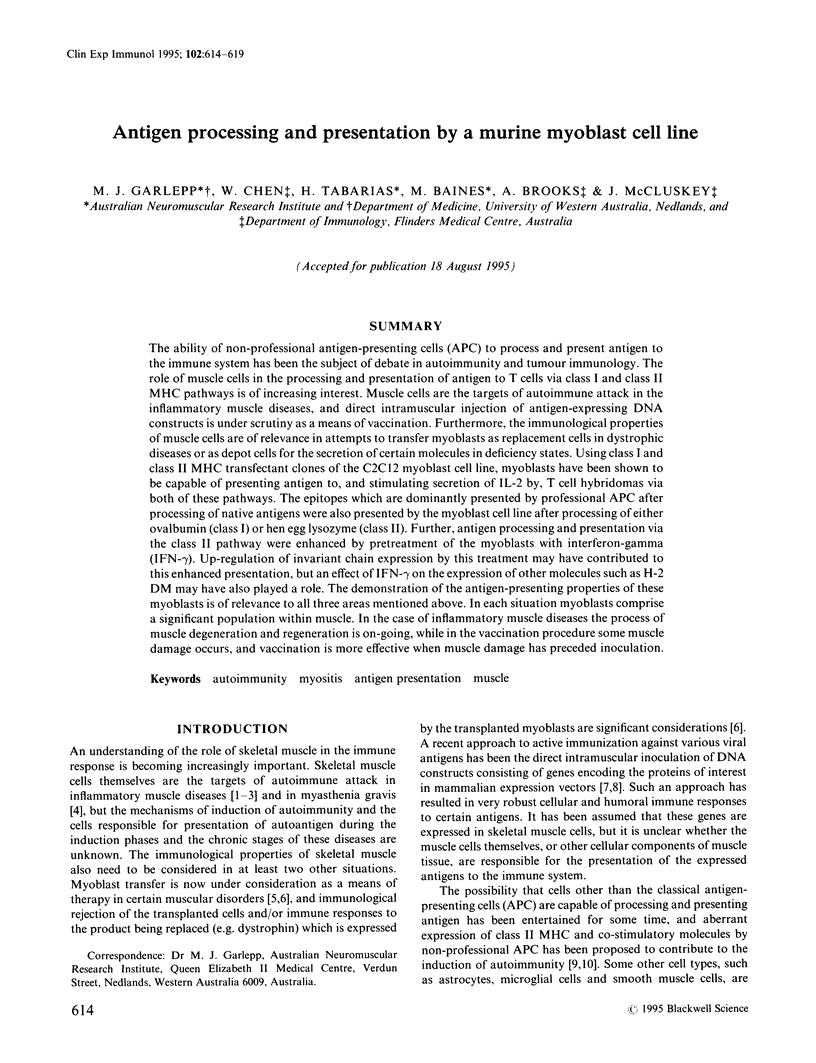
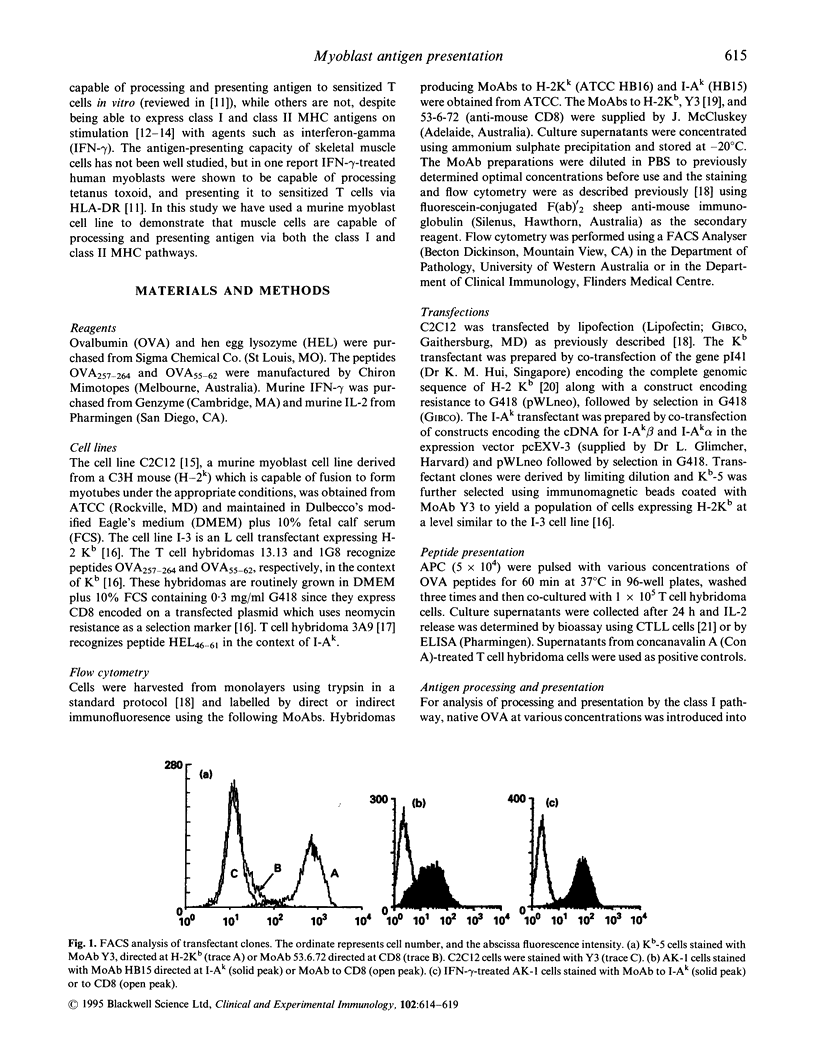
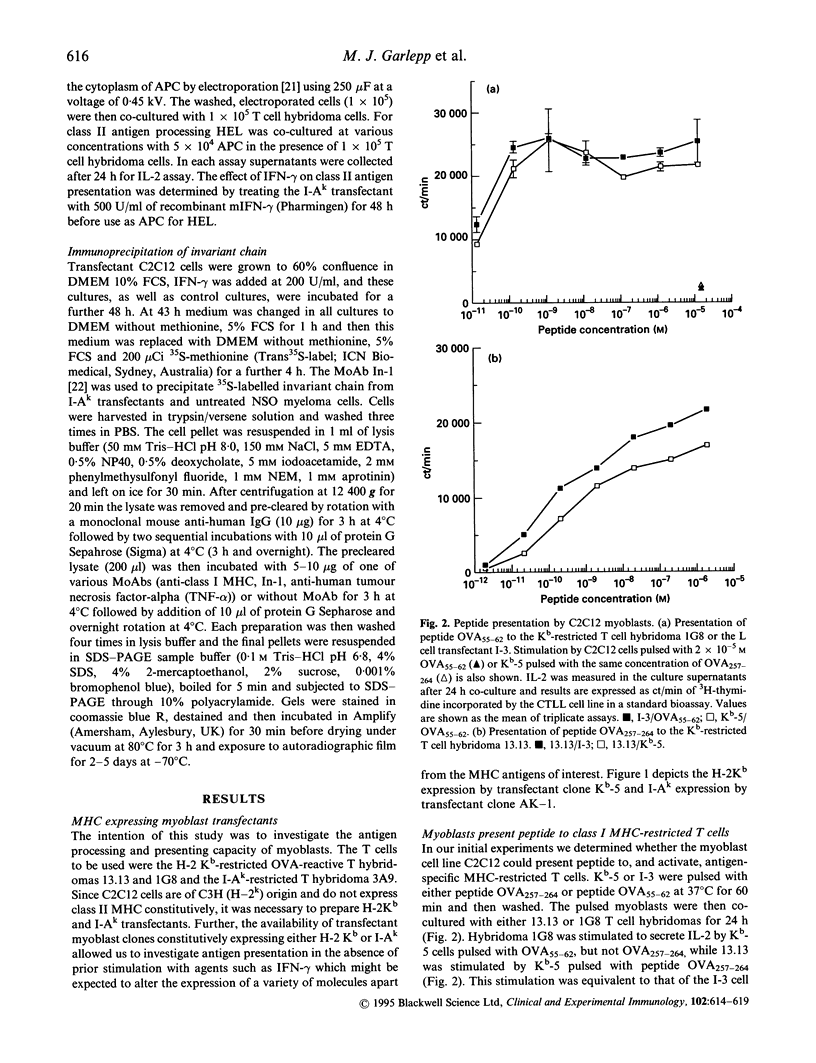
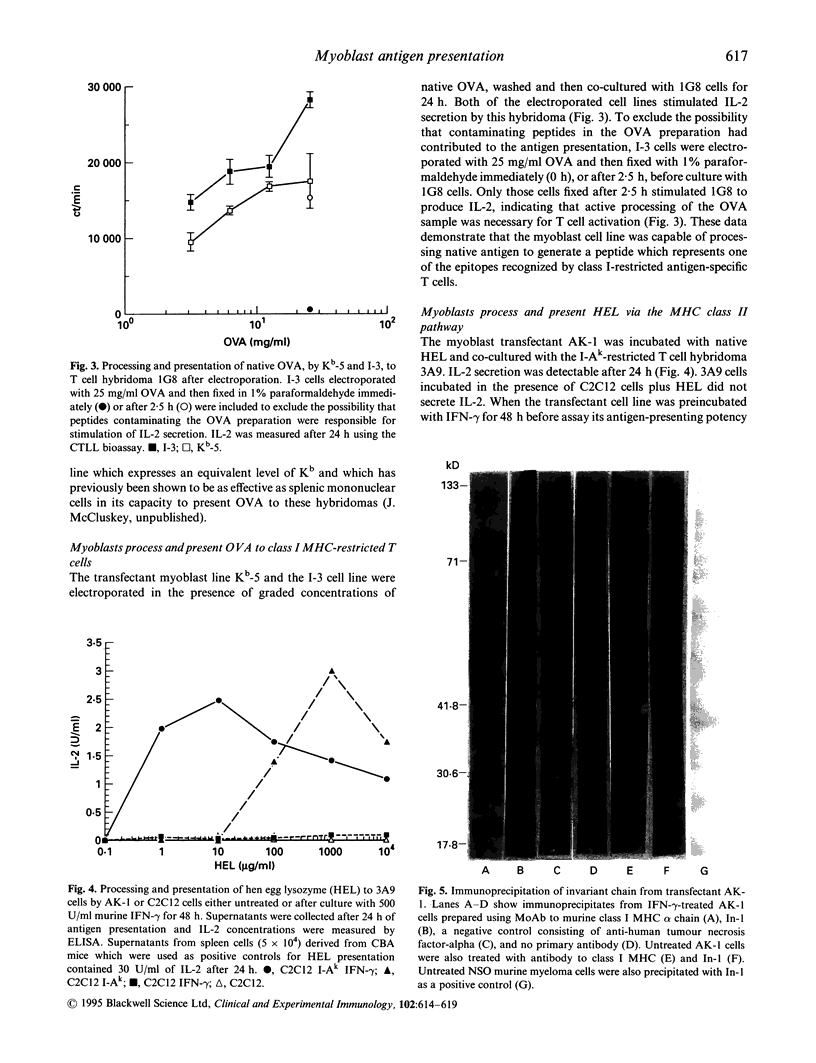
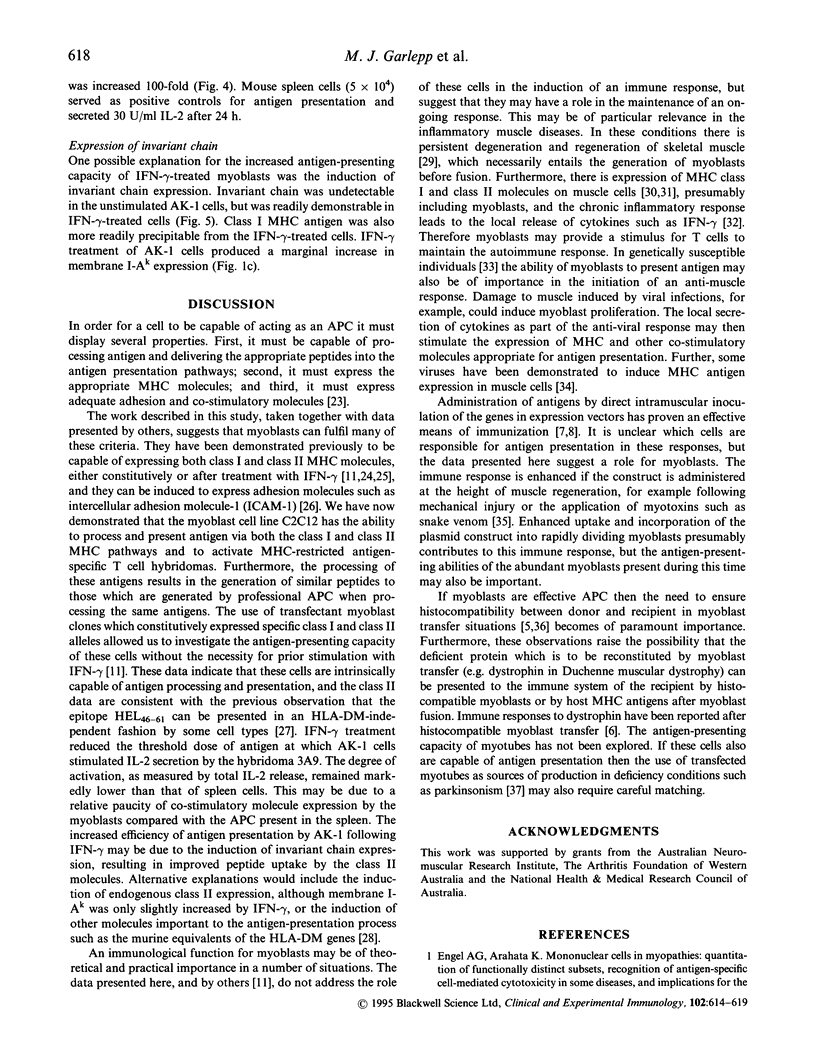
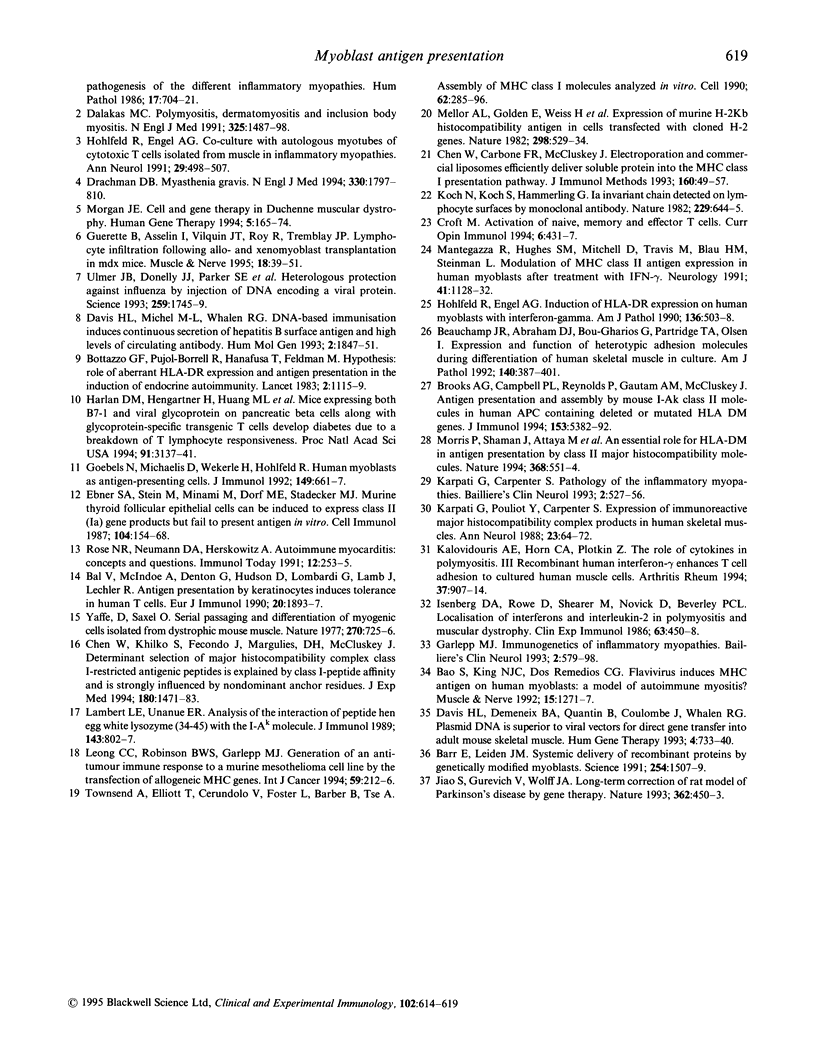
Images in this article
Selected References
These references are in PubMed. This may not be the complete list of references from this article.
- Bal V., McIndoe A., Denton G., Hudson D., Lombardi G., Lamb J., Lechler R. Antigen presentation by keratinocytes induces tolerance in human T cells. Eur J Immunol. 1990 Sep;20(9):1893–1897. doi: 10.1002/eji.1830200904. [DOI] [PubMed] [Google Scholar]
- Bao S., King N. J., Dos Remedios C. G. Flavivirus induces MHC antigen on human myoblasts: a model of autoimmune myositis? Muscle Nerve. 1992 Nov;15(11):1271–1277. doi: 10.1002/mus.880151109. [DOI] [PMC free article] [PubMed] [Google Scholar]
- Barr E., Leiden J. M. Systemic delivery of recombinant proteins by genetically modified myoblasts. Science. 1991 Dec 6;254(5037):1507–1509. doi: 10.1126/science.1962212. [DOI] [PubMed] [Google Scholar]
- Beauchamp J. R., Abraham D. J., Bou-Gharios G., Partridge T. A., Olsen I. Expression and function of heterotypic adhesion molecules during differentiation of human skeletal muscle in culture. Am J Pathol. 1992 Feb;140(2):387–401. [PMC free article] [PubMed] [Google Scholar]
- Bottazzo G. F., Pujol-Borrell R., Hanafusa T., Feldmann M. Role of aberrant HLA-DR expression and antigen presentation in induction of endocrine autoimmunity. Lancet. 1983 Nov 12;2(8359):1115–1119. doi: 10.1016/s0140-6736(83)90629-3. [DOI] [PubMed] [Google Scholar]
- Brooks A. G., Campbell P. L., Reynolds P., Gautam A. M., McCluskey J. Antigen presentation and assembly by mouse I-Ak class II molecules in human APC containing deleted or mutated HLA DM genes. J Immunol. 1994 Dec 15;153(12):5382–5392. [PubMed] [Google Scholar]
- Chen W., Carbone F. R., McCluskey J. Electroporation and commercial liposomes efficiently deliver soluble protein into the MHC class I presentation pathway. Priming in vitro and in vivo for class I-restricted recognition of soluble antigen. J Immunol Methods. 1993 Mar 15;160(1):49–57. doi: 10.1016/0022-1759(93)90007-t. [DOI] [PubMed] [Google Scholar]
- Chen W., Khilko S., Fecondo J., Margulies D. H., McCluskey J. Determinant selection of major histocompatibility complex class I-restricted antigenic peptides is explained by class I-peptide affinity and is strongly influenced by nondominant anchor residues. J Exp Med. 1994 Oct 1;180(4):1471–1483. doi: 10.1084/jem.180.4.1471. [DOI] [PMC free article] [PubMed] [Google Scholar]
- Croft M. Activation of naive, memory and effector T cells. Curr Opin Immunol. 1994 Jun;6(3):431–437. doi: 10.1016/0952-7915(94)90123-6. [DOI] [PubMed] [Google Scholar]
- Dalakas M. C. Polymyositis, dermatomyositis and inclusion-body myositis. N Engl J Med. 1991 Nov 21;325(21):1487–1498. doi: 10.1056/NEJM199111213252107. [DOI] [PubMed] [Google Scholar]
- Davis H. L., Demeneix B. A., Quantin B., Coulombe J., Whalen R. G. Plasmid DNA is superior to viral vectors for direct gene transfer into adult mouse skeletal muscle. Hum Gene Ther. 1993 Dec;4(6):733–740. doi: 10.1089/hum.1993.4.6-733. [DOI] [PubMed] [Google Scholar]
- Davis H. L., Michel M. L., Whalen R. G. DNA-based immunization induces continuous secretion of hepatitis B surface antigen and high levels of circulating antibody. Hum Mol Genet. 1993 Nov;2(11):1847–1851. doi: 10.1093/hmg/2.11.1847. [DOI] [PubMed] [Google Scholar]
- Drachman D. B. Myasthenia gravis. N Engl J Med. 1994 Jun 23;330(25):1797–1810. doi: 10.1056/NEJM199406233302507. [DOI] [PubMed] [Google Scholar]
- Ebner S. A., Stein M. E., Minami M., Dorf M. E., Stadecker M. J. Murine thyroid follicular epithelial cells can be induced to express class II (Ia) gene products but fail to present antigen in vitro. Cell Immunol. 1987 Jan;104(1):154–168. doi: 10.1016/0008-8749(87)90016-5. [DOI] [PubMed] [Google Scholar]
- Garlepp M. J. Immunogenetics of inflammatory myopathies. Baillieres Clin Neurol. 1993 Nov;2(3):579–597. [PubMed] [Google Scholar]
- Goebels N., Michaelis D., Wekerle H., Hohlfeld R. Human myoblasts as antigen-presenting cells. J Immunol. 1992 Jul 15;149(2):661–667. [PubMed] [Google Scholar]
- Guérette B., Asselin I., Vilquin J. T., Roy R., Tremblay J. P. Lymphocyte infiltration following allo- and xenomyoblast transplantation in mdx mice. Muscle Nerve. 1995 Jan;18(1):39–51. doi: 10.1002/mus.880180107. [DOI] [PubMed] [Google Scholar]
- Harlan D. M., Hengartner H., Huang M. L., Kang Y. H., Abe R., Moreadith R. W., Pircher H., Gray G. S., Ohashi P. S., Freeman G. J. Mice expressing both B7-1 and viral glycoprotein on pancreatic beta cells along with glycoprotein-specific transgenic T cells develop diabetes due to a breakdown of T-lymphocyte unresponsiveness. Proc Natl Acad Sci U S A. 1994 Apr 12;91(8):3137–3141. doi: 10.1073/pnas.91.8.3137. [DOI] [PMC free article] [PubMed] [Google Scholar]
- Hohlfeld R., Engel A. G. Coculture with autologous myotubes of cytotoxic T cells isolated from muscle in inflammatory myopathies. Ann Neurol. 1991 May;29(5):498–507. doi: 10.1002/ana.410290509. [DOI] [PubMed] [Google Scholar]
- Hohlfeld R., Engel A. G. Induction of HLA-DR expression on human myoblasts with interferon-gamma. Am J Pathol. 1990 Mar;136(3):503–508. [PMC free article] [PubMed] [Google Scholar]
- Isenberg D. A., Rowe D., Shearer M., Novick D., Beverley P. C. Localization of interferons and interleukin 2 in polymyositis and muscular dystrophy. Clin Exp Immunol. 1986 Feb;63(2):450–458. [PMC free article] [PubMed] [Google Scholar]
- Jiao S., Gurevich V., Wolff J. A. Long-term correction of rat model of Parkinson's disease by gene therapy. Nature. 1993 Apr 1;362(6419):450–453. doi: 10.1038/362450a0. [DOI] [PubMed] [Google Scholar]
- Kalovidouris A. E., Horn C. A., Plotkin Z. The role of cytokines in polymyositis. III. Recombinant human interferon-gamma enhances T cell adhesion to cultured human muscle cells. Arthritis Rheum. 1994 Jun;37(6):907–914. doi: 10.1002/art.1780370620. [DOI] [PubMed] [Google Scholar]
- Karpati G., Carpenter S. Pathology of the inflammatory myopathies. Baillieres Clin Neurol. 1993 Nov;2(3):527–556. [PubMed] [Google Scholar]
- Karpati G., Pouliot Y., Carpenter S. Expression of immunoreactive major histocompatibility complex products in human skeletal muscles. Ann Neurol. 1988 Jan;23(1):64–72. doi: 10.1002/ana.410230111. [DOI] [PubMed] [Google Scholar]
- Koch N., Koch S., Hämmerling G. J. Ia invariant chain detected on lymphocyte surfaces by monoclonal antibody. Nature. 1982 Oct 14;299(5884):644–645. doi: 10.1038/299644a0. [DOI] [PubMed] [Google Scholar]
- Lambert L. E., Unanue E. R. Analysis of the interaction of peptide hen egg white lysozyme (34-45) with the I-Ak molecule. J Immunol. 1989 Aug 1;143(3):802–807. [PubMed] [Google Scholar]
- Leong C. C., Robinson B. W., Garlepp M. J. Generation of an antitumour immune response to a murine mesothelioma cell line by the transfection of allogeneic MHC genes. Int J Cancer. 1994 Oct 15;59(2):212–216. doi: 10.1002/ijc.2910590213. [DOI] [PubMed] [Google Scholar]
- Mantegazza R., Hughes S. M., Mitchell D., Travis M., Blau H. M., Steinman L. Modulation of MHC class II antigen expression in human myoblasts after treatment with IFN-gamma. Neurology. 1991 Jul;41(7):1128–1132. doi: 10.1212/wnl.41.7.1128. [DOI] [PubMed] [Google Scholar]
- Mellor A. L., Golden L., Weiss E., Bullman H., Hurst J., Simpson E., James R. F., Townsend A. R., Taylor P. M., Schmidt W. Expression of murine H-2Kb histocompatibility antigen in cells transformed with cloned H-2 genes. Nature. 1982 Aug 5;298(5874):529–534. doi: 10.1038/298529a0. [DOI] [PubMed] [Google Scholar]
- Morgan J. E. Cell and gene therapy in Duchenne muscular dystrophy. Hum Gene Ther. 1994 Feb;5(2):165–173. doi: 10.1089/hum.1994.5.2-165. [DOI] [PubMed] [Google Scholar]
- Morris P., Shaman J., Attaya M., Amaya M., Goodman S., Bergman C., Monaco J. J., Mellins E. An essential role for HLA-DM in antigen presentation by class II major histocompatibility molecules. Nature. 1994 Apr 7;368(6471):551–554. doi: 10.1038/368551a0. [DOI] [PubMed] [Google Scholar]
- Rose N. R., Neumann D. A., Herskowitz A. Autoimmune myocarditis: concepts and questions. Immunol Today. 1991 Aug;12(8):253–255. doi: 10.1016/0167-5699(91)90118-D. [DOI] [PubMed] [Google Scholar]
- Townsend A., Elliott T., Cerundolo V., Foster L., Barber B., Tse A. Assembly of MHC class I molecules analyzed in vitro. Cell. 1990 Jul 27;62(2):285–295. doi: 10.1016/0092-8674(90)90366-m. [DOI] [PubMed] [Google Scholar]
- Ulmer J. B., Donnelly J. J., Parker S. E., Rhodes G. H., Felgner P. L., Dwarki V. J., Gromkowski S. H., Deck R. R., DeWitt C. M., Friedman A. Heterologous protection against influenza by injection of DNA encoding a viral protein. Science. 1993 Mar 19;259(5102):1745–1749. doi: 10.1126/science.8456302. [DOI] [PubMed] [Google Scholar]
- Yaffe D., Saxel O. Serial passaging and differentiation of myogenic cells isolated from dystrophic mouse muscle. Nature. 1977 Dec 22;270(5639):725–727. doi: 10.1038/270725a0. [DOI] [PubMed] [Google Scholar]



